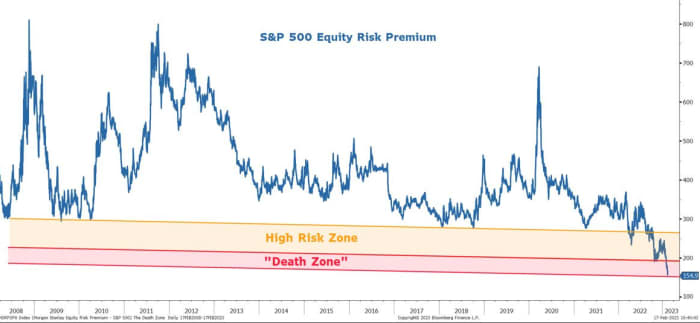What’s the best metaphor to describe the stock market, that has sent the S&P 500 up 16% from its October lows, and up 6% this year?
Morgan Stanley strategist Mike Wilson has turned to the Jon Krakauer best-seller “Into Thin Air,” which chronicles the death of 12 mountaineers trying to scale Mount Everest. The book delves into the death zone, which starts 3,000 feet from the mountain’s summit, an altitude where oxygen pressure isn’t sufficient to sustain life for an extended period.
“Either by choice or out of necessity investors have followed stock prices to dizzying heights once again as liquidity (bottled oxygen) allows them to climb into a region where they know they shouldn’t go and cannot live very long,” says Wilson. “They climb in pursuit of the ultimate topping out of greed, assuming they will be able to descend without catastrophic consequences. But the oxygen eventually runs out and those who ignore the risks get hurt.”
Wilson says that when stocks started rising in October, they had much lower valuation, with a price-to-equity ratio of 15 and an equity risk premium of 270 basis points. The equity risk premium is the difference between the expected earnings yield and the yield on safe Treasurys, with a higher number meaning investors are being compensated more for their investments in stocks.
By December, however, “the air started to thin” with P-to-Es down to 18, and the equity risk premium down to 225 basis points. “In the last few weeks of the year, we lost many climbers who pushed further ahead in the death zone,” he said.
But then 2023 started, and “the surviving climbers decided to make another summit attempt, this time taking an even more dangerous route with the most speculative stocks leading the way,” on the faulty premise of a Fed rate-hike pause, to be followed by cuts later in the year.
“Investors began to move faster and more energetically, talking more confidently about a soft landing for the U.S. economy. As they have reached even higher levels, there is now talk of a ‘no landing’ scenario – whatever that means. Such are the tricks the death zone plays on the mind – one starts to see and believe in things that don’t exist,” says Wilson.

Morgan Stanley
The “no landing” scenario is one most closely associated with Torsten Slok, the chief economist at Apollo Global Management. It should be noted that Slok says a no-landing scenario — where the economy does not slow down — is not good for markets, because it will require more aggressive Fed rate-hike activity.
Back to Wilson, who says the P-to-E ratio is now 18.6, and equity risk premium at 155 basis points, meaning “we are in the thinest air of the entire liquidity-driven secular bull market that began back in 2009.” He says the bear market rally that begin in October from reasonable prices has turned into a speculative frenzy based on a Fed pause/pivot that isnt coming.
Granted, he says, liquidity mostly boosted by Chinese and Japanese central banks has helped boost global M2 — a measure of the money supply — by $6 trillion since October, “providing the supplemental oxygen investors need to survive in the death zone” a bit longer.
The U.S. stock market is closed on Monday in observance of Washington’s Birthday. Last week, the Dow Jones Industrial Average
DJIA,
and S&P 500
SPX,
fell, while the Nasdaq Composite
COMP,
rose for the sixth time in seven weeks.
Source: https://www.marketwatch.com/story/investors-have-pushed-stocks-into-the-death-zone-warns-morgan-stanleys-mike-wilson-dcef3c63?siteid=yhoof2&yptr=yahoo
